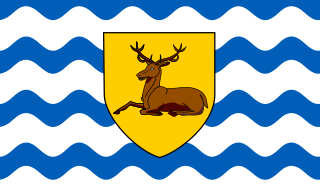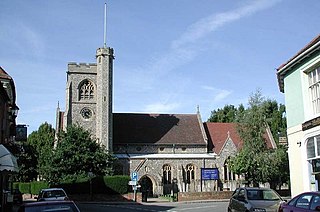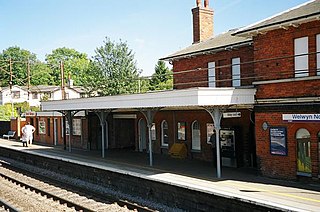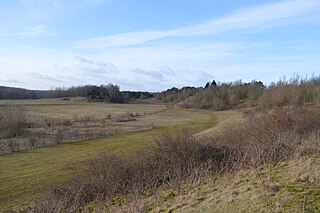
Panshanger was a large country house located between the outer edge of Hertford and Welwyn Garden City in Hertfordshire, England.

Panshanger was a large country house located between the outer edge of Hertford and Welwyn Garden City in Hertfordshire, England.

Earl Cowper, who later became Lord Chancellor of Great Britain, acquired the Cole Green estate c. 1700. [1] He remodelled the estate in 1704 and made alterations to the house in 1711. [2] The 5th Earl Cowper commissioned Samuel Wyatt and then William Atkinson to design a new house in a slightly different location in Regency-Gothic style; construction work started on site in 1806. [2] The park was landscaped with advice from Humphry Repton, [2] starting in 1799. [3] Following the death of the 7th Earl Cowper in 1905, the estate was inherited by Ethel Grenfell, Baroness Desborough [4] and, after she died in 1952 with no heir, the estate was sold in lots by auction the following year, but there was no interest in the house itself and it was demolished between 1953 and 1954. [3] A large portion of the outlying farms forming part of the estate had been sold by auction on 30 May 1919. [5]

The park contains the largest maiden (not pollarded) oak in the country, with a circumference of 7.6 metres. It is believed to have been planted by Queen Elizabeth I. Acorns from the tree have been used as seedlings for notable oaks in other parts of the country, such as the Prince Consort Oak in the Forest of Dean. Winston Churchill planted a sapling from the tree in the park and the tree can still be seen in the grounds. [6]

Panshanger Park is owned by Tarmac which extracts sand and gravel from the site. Although Panshanger House was demolished, the orangery, nursery garden wall, stables, and a number of cottages and estate buildings remain, [7] all of which are listed by English Heritage. [3]
The eastern end has been open since 31 March 2014 as a 1,000 acre country park and nature reserve - with 200 acres open to the public. The park consists of wetlands, grasslands and reedbeds which serve as a home for a wide variety of damselfly and dragonfly species. [8] The park is also home to kingfishers, waterfowl and osprey. [9] The rest of the site will be opened as gravel extraction is completed. [10]
The Panshanger district of Welwyn Garden City, and the nearby Panshanger Aerodrome, are named after the Panshanger estate. However, Panshanger Park does not lie within the Panshanger ward of Welwyn Garden City, nor indeed any part of Welwyn Garden City. It actually lies within the parishes of Hertford and Hertingfordbury. [3]

Hertfordshire is one of the home counties in southern England. It borders Bedfordshire and Cambridgeshire to the north, Essex to the east, Greater London to the south, and Buckinghamshire to the west. For government statistical purposes, it forms part of the East of England region.

Welwyn Garden City is a town in Hertfordshire, England, 20 miles (32 km) north of London. It was the second garden city in England and one of the first new towns. It is unique in being both a garden city and a new town and exemplifies the physical, social and cultural planning ideals of the periods in which it was built.

Welwyn is a village and civil parish in Hertfordshire, England. The parish also includes the villages of Digswell and Oaklands. It is sometimes referred to as Old Welwyn or Welwyn Village, to distinguish it from the much newer and larger settlement of Welwyn Garden City, about a mile to the south.
Francis Thomas de Grey Cowper, 7th Earl Cowper, known as Viscount Fordwich from 1837 to 1856, was a British Liberal politician. He was Lord Lieutenant of Ireland from 1880 to 1882.

Hertfordshire is an English county, founded in the Norse–Saxon wars of the 9th century, and developed through commerce serving London. It is a land-locked county that was several times the seat of Parliament. From origins in brewing and papermaking, through aircraft manufacture, the county has developed a wider range of industry in which pharmaceuticals, financial services and film-making are prominent. Today, with a population slightly over 1 million, Hertfordshire services, industry and commerce dominate the economy, with fewer than 2000 people working in agriculture, forestry and fishing.

Cassiobury Park is the principal public park in Watford, Hertfordshire, in England. It was created in 1909 from the purchase by Watford Borough Council of part of the estate of the Earls of Essex around Cassiobury House which was subsequently demolished in 1927. It comprises over 190 acres (77 ha) and extends from the A412 Rickmansworth Road in the east to the Grand Union Canal in the west, and lies to the south of the Watford suburb of Cassiobury, which was also created from the estate. The western part is a 62-acre (25.1 ha) Local Nature Reserve managed by the Herts and Middlesex Wildlife Trust. The park hosts the free, weekly timed parkrun 5 km event every Saturday morning at 9 am, starting near the Shepherds Road entrance to the park.

Brocket Hall is a neo-classical country house set in a large park at the western side of the urban area of Welwyn Garden City in Hertfordshire, England. The estate is equipped with two golf courses and seven smaller listed buildings, apart from the main house. The freehold on the estate is held by the 3rd Baron Brocket. The house is Grade I-listed.

Welwyn North railway station serves the villages of Digswell and Welwyn in Hertfordshire, England. The station is located 22 miles (35 km) north of London King's Cross, on the East Coast Main Line. Train services are currently provided by Thameslink.

Digswell is an ancient village and former parish in the English county of Hertfordshire which is recorded in the 1086 Domesday Book. The population of the urban area of Digswell in the 2011 Census was 1,632.

Stanborough Park, also referred to as Stanborough Lakes is a 126-acre (0.51 km2) park in Welwyn Garden City, Hertfordshire, England.
Hertford was the name of a parliamentary constituency in Hertfordshire, which elected Members of Parliament (MPs) from 1298 until 1974.

Panshanger Aerodrome was a former general aviation aerodrome located on the most eastern tip of Welwyn Garden City, Hertfordshire, England, 2.5 NM west of Hertford, East Hertfordshire.

Hertingfordbury is a small village in Hertfordshire, England, close to the county town of Hertford. It was mentioned in the Domesday Book. Hertingfordbury is also the name of a neighbouring civil parish, which does not contain the village. Hertingfordbury Village is located within the Castle ward of local government Hertford Town Council. The population of the civil parish as of the 2021 census was 689.

The Niccolini-Cowper Madonna, also known as the Large Cowper Madonna, is a painting by the Italian High Renaissance artist Raphael, depicting Mary and Child, against a blue sky.

Digswell House is a Grade II listed Mansion in Hertfordshire, erected c. 1805–07 by Samuel Wyatt for the Honourable Edward Spencer Cowper, who lived there for some years. It was built in the parish of Digswell from which it takes its name, but was transferred to Welwyn Garden City in 1921. The house is now in the Knightsfield area of Welwyn Garden City. The current house was erected a little eastward of the site on which its predecessor had stood and was built as a commodious country gentleman's home, in an architectural style that can best be described as neoclassical. A portico, with four massive Ionic columns, on the south front is its most impressive external feature.

Waterford Heath is a 35.2 hectare Local Nature Reserve in Waterford in Hertfordshire, England. It is owned by Lafarge Tarmac and managed by the Herts and Middlesex Wildlife Trust together with East Hertfordshire District Council and Lafarge.

Hertford Heath nature reserve is a 28 hectare biological Site of Special Scientific Interest in Hertford Heath in Hertfordshire. It is managed by the Herts and Middlesex Wildlife Trust and the local planning authority is East Hertfordshire District Council.